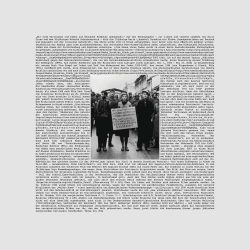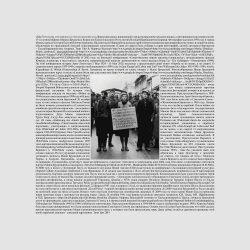2 large banners, each with image and text (Russian and German), black and white against a grey background, width 100 cm x height 100 cm, printed on Powertex Blockout material (width 140 cm x 140 height) to be presented hung on a line.
Print version 210 height x 260 mm width
Web site: www.tanyaury.com
all in a name is the English title to the photo and text artwork, about the Jewish, Soviet partisan, Masha Bruskina, presented as 2 banners (Russian and German); the German title of the same narrative piece is the motto “Nomen est Omen”, from the Latin proverb “all in a name”. This work is also dedicated to Ella Unger and Grette Schiemann, great aunts, who were deported from Cologne to concentration camps:
Margarete Schiemann neé Unger, born 1903
Deported: 1941 Riga: murdered
Stolperstein für Margarete Schiemann (Zülpicher Platz 4, Köln)
| Ella Unger | |
| Birthdate: | November 20, 1899 |
| Birthplace: | Hohensalza | Inowroclaw, Inowrocław County, Kuyavian-Pomeranian Voivodeship, Poland |
| Death: | December 04, 1944 (45) KZ Stutthof | Sztutowo, Pomeranian Voivodeship, Poland (murdered) |
www.geni.com/people/El…
***
“We are partisans and have shot at German soldiers.”
Holding the placard, with the hand-written inscription, in German and Russian is 17-year-old Maria (Masha) Bruskina — to her left and right, Kiril Trus and 16-year-old Volodia Shcherbatsevich, respectively. This photo was taken in Minsk 1941, shortly before all three were publicly hanged. Fact was that Masha had been a nurse, who had assisted wounded Red Army soldiers, by providing them with civilian clothes and papers, so that they might join the Resistance.1
In 2002 I gave a slide reading of my narrative Die Gehängten – Hung Up (1999) at “Jewish Resistance against National Socialism”, held by the Konrad Adenauer Foundation, in Bonn. At this conference, the historian Arno Lustiger2 gave a presentation related to his book, during which he spoke of Masha Bruskina: “To Fight for Life or Death! The Jewish Resistance 1933−1945” was first published in 19943.
The photographic portrayals of Masha Bruskina before and after being hanged were already known to me4 – they have been put into service by the media to represent partisan resistance against the fascist hegemony, ever and again after World War 2. But I did not know the history of these iconic images, which I had also seen more recently in the exhibition “War of Destruction, Crimes of the German Army 1939−45”, when it came to Cologne in 1999.
Arno Lustiger explained that the pictures of Bruskina’s execution on 26th October 1941 were well known in the Soviet Union – one of these had been shown in Mikhail Romm’s film “Ordinary Fascism”, 1965. There had been no indication of who she was, or that she was Jewish, however. After the war this failure was not immediately remedied – until recently the Minsk War Museum photo had been merely entitled: “Execution of an unknown partisan” — Masha’s uncle, the renowned sculptor and Soviet Member of Parliament Sahir Asgur, had been forced to silence on the identity of his niece for decades5. And so, due to Soviet anti-Semitism, Masha Bruskina, who had been a very young Jewish partisan, remained anonymous, till after the cold war.
I checked my copy of the exhibition book “War of Destruction, Crimes of the German Army 1939−45”, Hamburger Edition 1995, only to discover that here only images6 of the hangings were shown and had also been titled without personal details.
After writing to Arno Lustiger in 2003 about the failure to identify Masha Bruskina, he replied that he had in fact been in contact with Hannes Heer and Klaus Naumann, the editors of the accompanying German Army exhibition book but had merely come up against a brick wall. Deplorably, the identical oversight still exists in the 2004 CD-ROM edition of the same book7.
In 2008 I was on a panel together with Catherine Plum, of Western New England College, USA at the Popular Culture Association conference in San Francisco. In her lecture she spoke of 18-year-old Zoya Kosmodemyanskaya, who had been executed for her activities as a partisan. The image of her hanging that Plum showed us bore similarities to Bruskina’s tragic portrait. Kosmodemyanskaya was however, soon acknowledged as a hero of her nation — a children’s pioneer camp, the optional educational choice in the Soviet Union that taught the history of anti-fascism, as well as leadership skills, had been named after her.
In Germany: “Since the 1970s, Sophie Scholl from Ulm has been celebrated as one of the great German heroes who actively opposed the Third Reich during the Second World War.”8 Several films have been made about her life and death. On 22nd February 1943, Scholl was guillotined, at the age of 21 years, for distributing pacifist leaflets with the “White Rose”, a non-violent anti-fascist, Resistance group.
Up to 2009, Bruskina’s name was not acknowledged on the memorial plaque at the execution place. Instead she was referred to as “the unknown girl”. However, since 2009, a new memorial plaque at the execution place has been placed. The Russian inscription now reads “Here on October 26, 1941 the Fascists executed the Soviet patriots K. I. Truss, V. I. Sherbateyvich and M.B. Bruskina”.9
Unlike Kosmodemyanskaya and Scholl, Bruskina was not even granted an identity, until well after the Soviet Union collapsed, but also not in the most significant German historical archival work on the 2nd World War10. Masha’s image was powerful and successfully instrumentalised as propaganda by the Soviet Union. She and her family were however powerless to correct the half-truths of the revisionist image that was presented to the world. Even now recognition of this young Jewish Soviet partisan remains modest.
1 “The scene of their deaths was captured in a series of powerful photographs taken by one of the Lithuanian Wehrmacht collaborators.” www.executedtoday.com/…
2 Arno Lustiger, May 7, 1924 – May 15, 2012
3 “Zum Kampf auf Leben und Tod! Vom Widerstand der Juden 1933 – 1945“ 1994, publ. Kiepenheuer & Witsch, Germany
4 Ibid 1
5 From the chapter “Säuberung“ des Anteils jüdischer Partisanen am Widerstand durch die sowjetische Geschichtsschreibung” (Soviet Historiographical Elimination of the Participation of Jewish Partisans in the Resistance), page 370, ibid 1. (Translation Tanya Ury)
6 Unnamed portrait of Masha Bruskina on page 494 of Vernichtungskrieg, Verbrechen der Wehrmacht 1941 bis 1944 (War of Destruction, Crimes of the German Army 1939 – 45), Hamburger Edition 1995.
7 In the DVD the title to Masha Bruskina’s portrait reads thus “Die erste Erhängung in Minsk am 26.10.1941 — Bundesarchiv, Bild 146/72/26/43“ (The first hanging in Minsk on 26.10.1941).
10 “Vernichtungskrieg, Verbrechen der Wehrmacht 1941 bis 1944” (War of Destruction, Crimes of the German Army 1939 – 45), Hamburger Edition 1995.
***
Information
Concept and text Tanya Ury
Digital image processing Ingolf Pink
German translation Tanya Ury and Amin Farzanefar
Russian translation Marina Walther
Presentation
Group Exhibitions
2015 (19.4. – 1.11.) Tanya Ury presents Имя говорит само за себя, nomen est omen — all in a name 1 & 2, 2014 in Frauen in Krieg und Frieden – Women during War and Peace, Frauenmuseum (Women’s Museum) Bonn (D)
Festivals etc.
2017 (3.7.) Personal statement by Tanya Ury on her Who’s Boss, nomen est omen artworks and Katy Deepwell’s n.paradoxa publication, on its 20th anniversary, at a special conference on Local and Global Dynamics in Contemporary Art at the University of Middlesex, London (GB)
Publications & Press
Artist’s Writings & Publications
2015 (1) Publication of Публикация Имя говорит само за себя – nomen est omen — all in a name – in the War issue, volume 35, n.paradoxa, International Feminist Art Journal, London (GB)
2015 (19.4. – 1.11.) Tanya Ury’s Имя говорит само за себя, nomen est omen — all in a name is presented the catalogue to “Frauen in Krieg und Frieden, 15−45−15, Geschichte, Dokumente, zeitgenössische Kunst“ Women during War and Peace, 15−45−15, History, Documents, Contemporary Art, Frauenmuseum (Women’s Museum) Bonn (D)
2017 (1.8.) Personal statement by Tanya Ury on her Who’s Boss, nomen est omen artworks for Katy Deepwell’s n.paradoxa publication (GB), on its 20th anniversary online: www.ktpress.co.uk/conf…

